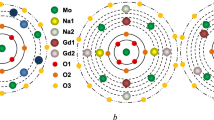Abstract
Abnormal scatterings of X-rays take place between Bragg spots. Their study in hydrated Mg- and Ni-vermiculites shows that they appear in reciprocal space in the form of modulated lines, elongated along the Z* axis. These scatterings demonstrate a two-dimensional organization of the compensating cations and of the water molecules in the interlamellar layer. In such ordered domains, the cations are situated at the nodes of a biperiodic centered lattice with parameters 3a,b.
The distribution of compensating cations must conform with the charge distribution which they neutralize; it can therefore be concluded that the distribution of effective negative charges (tetrahedral negative charges less positive octahedral charges) is also at least partially ordered.
Résumé
Des diffusions anormales des rayons X existent entre les taches de Bragg. Leur étude, dans le cas des vermiculites Mg- et Ni-hydratées, montre qu’elles apparaissent dans l’espace réciproque, sous forme de lignes modulées, allongées le long de l’axe Z*. Ces diffusions démontrent l’existence d’une organisation bidimendionnelle des cations compensateurs et des molécules d’eau dans l’espace interlamellaire. Dans de tels domaines ordonnés, les cations sont situés aux noeuds d’un réseau bipériodique centré, de paramètres 3 a, b.
La distribution des cations compensateurs doit se conformer à la distribution des charges qu’ils neutralisent; on peut ainsi en conclure que la distribution des charges négatives efficaces (charges négatives tétraédriques moins charges positives octaédriques) est ordonnée elle aussi au moins en partie.
Kurzreferat
Unnormale Streuung von Röntgenstrahlen finden zwischen den Bragg’schen Punkten statt. Bei der Untersuchung an hydratisierten Mg- und Ni-Vermiculiten zeigen sie sich im reziproken Raum in Form modulierter Linien, die entlang der Z*-Achse verlängert sind. Diese Streuung weist auf eine zweidimensionale Anordnung der zum Ladungsausgleich gebundenen Kationen und der Wassermoleküle in den Zwischenschichten hin. In solchen geordneten Bereichen befinden sich die Kationen an den Knoten eines biperiodisch zentrierten Gitters mit den Parametern 3a, b.
Die Verteilung der Kationen muß mit der Verteilung der Ladungen übereinstimmen, die sie kompensieren. Daher kann geschlossen werden, daß die Verteilung der wirksamen negativen Ladungen (negative Tetraederladung abzüglich positive Oktaederladung) gleichfalls mindestens teilweise geordnet vorliegt.
Резюме
Ненормальное рассеивание рентгеновских лучей происходит между брэгговскими пятнами. Их исследование в гидратированном М§ и № вермикулитах показало, что они появляются в сопряженном пространстве в форме модулированных линий, удлиненных по оси Z*. Это рассеивание демонстрирует двухмерную организацию компенсирующих катионов и присутствие водяных молекул в интерламинарном слое. В таких хорошо организованных владениях катионы находятся на узловых точках двуякопериодически центрированной решетки с параметрами За, Ь.
Распределение компенсирующих катионов должно согласоваться с распределением заряда, который они нейтрализуют; поэтому можно заключить, что является необходимым распреде¬ление эффективного отрицательного заряда (тетраэдральные отрицательные заряды минус октаэдральные положительные заряды).
Similar content being viewed by others
References
Bradley, W. F. and Serratosa, J. M. (1960) A discussion of the water content of vermiculite: Clay. and Clay Minerals 7, 260–270
Grüner, J. W. (1934) The structures of vermiculite. and their collapse by dehydratation: Amer. Min. 19, 557–575.
Hendricks, S. B. and Jefferson, M. E. (1938) Crystal structure of vermiculite. and mixed vermiculite-chlorites: Amer. Min. 23, 851–862
Mathieson, A. Mel (1958) Mg-Vermiculite: a refinement of the crystal structure of the 14-36Â phase: Amer. Min. 43, 216–227
Mathieson, A. Mel. and Walker, G. F. (1954) Crystal structure of magnesium vermiculite: Amer. Min. 39, 213–225
Shirozu, H. and Bailey, S. W. (1966). Crystal structure of a two-layer Mg-vermiculite: Amer. Min. 51, 1124–1143
Walker, G. F. (1956). The mechanism of dehydration of Mg-vermiculite: Clay. and Clay Minerals 4, 110–115
Author information
Authors and Affiliations
Rights and permissions
About this article
Cite this article
Alcover, J.F., Gatineau, L. & Mering, J. Exchangeable Cation Distribution in Nickel- and Magnesium-Vermiculites. Clays Clay Miner. 21, 131–136 (1973). https://doi.org/10.1346/CCMN.1973.0210209
Received:
Published:
Issue Date:
DOI: https://doi.org/10.1346/CCMN.1973.0210209




